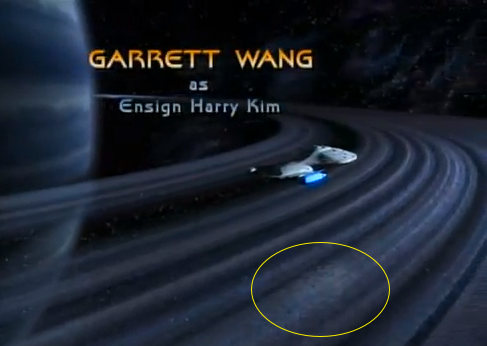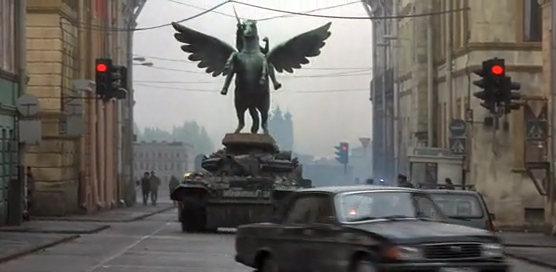I recall that, when I first saw the movie 2001: A Space Odyssey, I was struck by this scene:
It shows the monolith that had been discovered near the crater Tycho, with the earth low in the sky. The image jarred me; the earth shouldn’t be in gibbous phase. Later I checked it out and found that my suspicions were correct. Tycho is at a lunar colongitude of 12º. This means that when the sun rises on Tycho, as depicted in this image, the moon is 12º past first quarter, meaning that, from earth, it will look a bit more than half-full. But here’s the trick: the phase of the earth as seen from the moon is always the reverse. When the moon is full as seen from the earth, the earth is new as seen from the moon. When the moon is half-full as seen from the earth, the earth is half-full (in the opposite direction) as seen from the moon. Since sunrise on Tycho occurs when the moon is slightly more than half-full as seen from earth, the earth should be slight less than half-full as seen from the moon – and in the opposite direction. This image is geometrically impossible. Oh, and one other thing: since Tycho is at a lunar latitude of 43ºS, the earth must be at an angular altitude of about 47º, not just above the horizon as in this image.
I was so proud of myself for having figured this out. And over the years, I caught lots of other science-type mistakes in movies and TV shows. Not just the ‘faster-than-light travel is impossible’ mistakes; I took pleasure in catching small but utterly impossible situations. Here’s another of my favorites:

I have circled in yellow the reflection of the starship Voyager on the rings of the planet. It’s easier to notice in the video, where the reflection is clearly moving along with the starship.
Look how big that reflection is. It spans hundreds of miles of ring surface – which means of course that the starship must be hundreds of miles long. Oops!
It’s a STORY!
I was proud of myself for detecting mistakes like this – until I started to understand the nature of story. Stories need not be factually correct. Indeed, realism is utterly unnecessary to stories. Do you really expect that toys can come to life (Toy Story), that magic is real (Harry Potter), that Middle Earth existed (The Lord of the Rings), or that we are all living inside a computer simulation (The Matrix)? These movies are all based on patently false assumptions, yet nobody cries foul.
Stories adhere to strict dramatic laws, not physical laws. A story must make dramatic sense above all; if this entails violating real-world logic, that does not harm the story.
The same thing applies to plot holes. I was once incensed by a ghastly plot hole in the movie The Spanish Prisoner. It included a long, complicated chase scene, with the protagonist making all sorts of wild and wooly escapes. At the end of the chase scene, the protagonist leaps from the pier and just barely makes it to a departing ferry. Safe at last! He goes inside the ferry to sit down – and the chief villain is sitting there waiting for him! How could that villain have possibly anticipated the many twists and turns of the chase scene and known that the protagonist would end up there?
Here’s where I soften my criticism of the nitpickers – but with a proviso. Yes, an illogical event can be a basis for criticizing a story, but only if the event violates the dramatic logic of the story. Had the villain in The Spanish Prisoner been equipped with super-powers, we’d have no problem with his foreknowledge. But the movie presented an otherwise normal world with normal people, normal cars, and so forth. A grossly abnormal development in an otherwise normal world is dramatically inconsistent, not just logically inconsistent.
The James Bond movies exemplify the difference between dramatic logic and physical logic. All sorts of preposterous things happen in these movies. One of my favorites is the tank chase in Goldeneye, in which James Bond drives a tank through a monument, with the statue on top of the monument somehow falling onto and remaining on top of the tank:

This is utterly ridiculous, but that’s part of the dramatic logic of the Bond movies, which thrive on the absurd. In any other movie, a scene like this would be dismissed as nonsense, but it’s perfectly logical (dramatically) in a James Bond movie.
The Moral of this Tale…
is that all the ‘gotcha’ talk about inaccuracies, unrealistic actions, and plot holes is a bunch of malarky. No story need ever conform to physical reality or logic; it must instead strictly adhere to dramatic logic.
